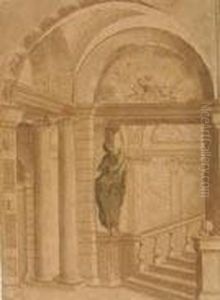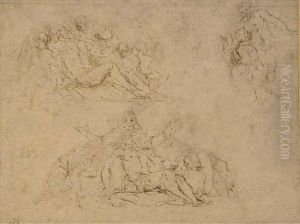Angelo Michele Colonna Paintings
Angelo Michele Colonna was an Italian Baroque painter, known primarily for his work in Bologna during the 17th century. Born in 1600 in Bologna, he became part of the rich artistic scene there, which was heavily influenced by the Carracci family, founders of the Bolognese School of painting. While there is not a vast amount of specific biographical information widely available about Colonna, his contributions to art during this period were notable.
Colonna’s style was characterized by its combination of the dynamism found in Baroque art with the clarity of the High Renaissance. He was particularly adept at fresco painting and worked on several important projects during his career. His works often featured religious themes, as was typical for the time, reflecting the demands of the Counter-Reformation and the Church's desire to communicate religious narratives clearly and emotionally to the faithful.
As was common among artists of his era, Colonna collaborated with other painters. He worked alongside fellow artist Giovanni Battista Speranza and also collaborated with artists like Flaminio Torre. Together, they created works that adorned the churches and palaces of Bologna, contributing to the city's reputation as a center of artistic excellence.
Angelo Michele Colonna’s contributions to the Baroque movement are part of the larger tapestry of 17th-century Italian art. He passed away in 1687, having spent his life creating works that would influence the visual language of the Baroque period in Italy. While he may not be as well-remembered as some of his contemporaries like Guido Reni or Guercino, his work remains an important part of the cultural heritage of Bologna and the Baroque era.


